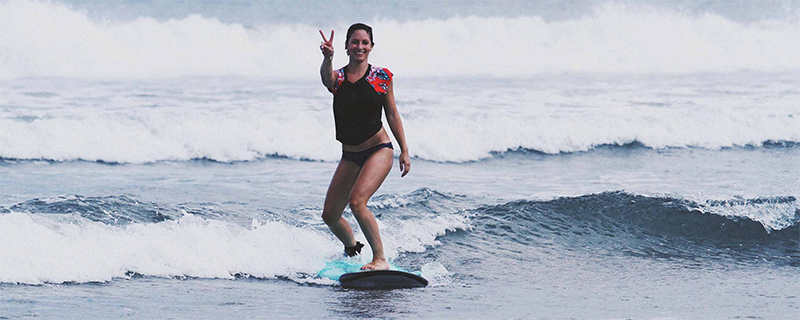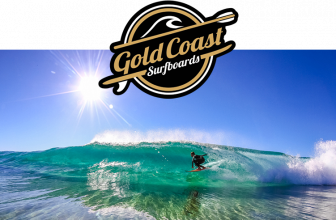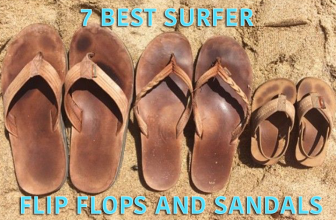
Ever wanted to try a hand at surfing, though maybe you were too nervous to get out there and try it?
More...
The idea of learning to surf is much scarier than the actual thing, and if you truly want to, failure is not an option. If you’re looking to learn, we’re here to help you get started!
We’ve put together 30 of our best surf tips from experience that will help any beginner surfer in starting their surf journey. As a preface to this article, remember that no one in history has ever hopped on a surfboard just to become an expert overnight.
Surfing takes time, dedication, and patience. Put in some time and effort, and make sure to follow these tips to become the best surfer you can be! Let’s get started.
#1 Find Someone to Surf With
Surfing may look easy when you’re watching all the shredders down at your local shores. The thing is, it’s not, and can be very dangerous if you don’t know what you’re doing. This is why we never recommend trying to approach surfing alone. Make sure that you grab a friend, or better yet, go to a surf camp where you can take lessons from an instructor. There are instructors all over the world that can prep you with the basics and coach you on your every move. This way, you can reduce the likelihood of getting hurt or hurting someone else.
#2 Get In Shape
This is the most overlooked part of starting out as a surfer. Many surfers practice cross-training in order to stay in shape for their surfing. Some skate, some do yoga, some run, etc. Surfing is a full-body sport that utilizes all muscle groups. You must have strong arms for paddling and a strong core for staying balanced once you’ve popped up. Lifting some weights to increase those muscles can be helpful, as well as doing a bit of cardio to get your stamina up.
#3 Find a Solid Instructor
If you do end up going with our advice above and decide to find an instructor to get you started, make sure that you do some research to make sure the instructor is legit. The instructor you choose should hopefully have had some experience teaching already, as well as some past clients that have left good reviews. Good instructors should also go beyond teaching you the fundamentals or the mechanics. They should look to inspire and motivate you so that you fall in love with the sport.
#4 Get a Big Board
You might want to get out there with a little shred stick and get started, though you’ll find yourself becoming a lot more frustrated than actually having fun. This is because shortboards are for intermediate and advanced surfers. They have far less buoyancy and stability and are just plain harder to ride. The best advice that I got when I started surfing was to start on a longer surfboard as a beginner. Longer and larger boards offer far more surface area, acting kind of like flotation devices out on the water. Stability and balance are the two most important things when you are starting, and getting a larger board can help you with both.
#5 Soft-Top Boards
Soft-top surfboards are the best kind of boards for beginners for many reasons. Soft-tops are far easier on your feet, helping you to ride more comfortably. Consider the fact that you’ll probably be sitting on this board a lot too, getting used to the feeling of the waves beneath you. Beyond that, soft-top boards are typically more buoyant than hard-top boards, making them easier to ride. This means they can also be used in smaller, foamier conditions, exactly what a beginner should be riding. Lastly, they are far safer than hard-top boards. You’ll most likely be spending a lot of time falling off your board. The last thing you want is to have the board fly out from under you and knock your teeth out, or even worse, knock the teeth out of the aggro local surfer who is now going to teach you a lesson with his fists. Go foam please.
#6 Get a Leash
Like I said, you’re going to be spending a lot of time falling off your board. A leash is the best safety precaution for when this happens, and safety is ALWAYS the most important. Wearing a leash is going to take a while for you to get used to, and it will most likely feel like it’s getting in the way all the time, though the more you use it, the more it will feel second nature. Leashes can help you from losing your board to the ocean deep, though they can also save your life if you lose your board and you’re further out from shore than you can swim.
#7 Get the Right Wetsuit
When figuring out which one is right for you, there are a few factors to consider. Water temperature is going to have a major impact on your surfing if you don’t have the right wardrobe. Some tropical waters close to the equator will rise into the 70-degrees Fahrenheit range all year round. In this case, you might only need a good pair of boardshorts or a one-piece for the ladies, a rash guard, and possibly a shirt if you need extra sun protection. If you are in a place where the water gets really cold during the winter (as it does in most places), you’ll definitely want to invest in a good wetsuit. Get a good long-sleeve neoprene wetsuit for winters and a springsuit for the spring and summer time.
#8 Learn How To Carry Your Board
Don’t be a kook. Learn how to carry your board the right way. Carry your board under your arm, either on your left or right side. If it gets to heavy, throw it atop your head like a big fruit basket. Don’t carry it in front of you unless you want to fall on your face, and please lord do not drag it by the nose or the leash. It’s a great way to look like a noob while simultaneously destroying the rails of your board.
#9 Do a Bit Of Exercise Pre-Paddle Out
Any smart athlete is going to warm up before they get out in the water. It is very important that you do the same, as you’re now a water athlete, right? There are some great surfing exercises for beginners out there that will carry on as you get better and better. Stretching out your muscles and tendons will reduce the risk of getting a cramp while you’re out in the water. Stretching and warming up also helps to increase your heart rate, pulling oxygen into your bloodstream and getting you pumped for the waves you are about to destroy. Never hit the water cold!
#10 Choose The Right Beach
Going to the correct beach is extremely important! Many surfers make the mistake of going to beaches where waves are far out of their league. Typically, you’ll be able to find a good beginner beach near you by simply looking it up. Popular beginner beaches will also typically have instructors or surf schools stationed out on them, as these experts know the correct waves for beginners. If you can’t seem to find one by looking it up, just look at the waves. You’ll want waves that are steadier and smaller without too many people in them, as there’s nothing worse than learning to surf with a swarm of beachgoers around you.
#11 Know the Geography of the Beach
Understanding how your beach is laid out can make your surfing experience much safer. I’ll never forget one of my first times surfing by myself when I decided to go far north of the pier in Santa Monica, only to find that no one was surfing out there because of the quick slope. I learned the hard way when I literally surfed my board right into the sand and broke my fins in front of a bunch of tourists. Make a note of the beach your surfing at. Is there a reef? Are there rip currents that you should watch out for? How about rocks? When do high and low tides occur?
#12 PRACTICE A FEW THINGS ON THE SAND
Before you hop in the water, spend a bit of time on the sand. After you do your light exercises, spend a bit of time meditating and thinking about the time you are about to spend on the water. Lie your board down on the sand without the fins on the bottom and practice some pop ups on it. Go through the motions of surfing on land and get your body used to them. Also, make a small checklist in your mind so that you are certain you have everything you need. Do you have your leash? Does your board have wax? Are your fins on tightly? How does your wetsuit feel?

#13 Analyze the Waves
Many a times you’ll hit the beach and see surfers staring longingly into the ocean. No, they’re not spacing out or feeling existential... okay, maybe some of them, though for the most part, they are analyzing the waves that they are about to go into. They’re seeing where they are breaking. This might be hard to read your first couple of times, so we recommend watching other surfers to see what it is that they are doing. Let it be known that this is also one of the best surfing tips for intermediate surfers, as you should ALWAYS check the waves out before you go in. Never assume you know Mother Nature.
#14 Take A Deep Breath
Remember, this is supposed to be fun! I know that learning an entirely new sport can be incredibly overwhelming. Hell, learning anything new can be overwhelming! Being scared or nervous is only going to make it worse though. Get in a bit of meditation, listen to your favorite song, or find whatever way you can to center yourself. You’re not surfing because you want it to scare you, you are surfing because you want to have an exciting time! Take a deep breath and think about how badass that first wave will be. You got this!
#15 Take It Easy Once You Are In the Water
When you finally get in the water, remember to take it slow. It’s easy to get excited and want to go straight for the big waves, though if you don’t pace yourself and take it slow, you could risk getting tired quickly or possibly injuring yourself. This is good advice in life as well. Take things slow and live in every moment of your surfing experience. Remember how each movement feels so that you can internalize them and use them the next time you hit the water. This is not a race.
#16 Hit the Small Waves
This might be some pretty obvious advice, though we want to make sure you have it in your head. Start with the small waves before EVER attempting to hit the bigger ones. You might feel super centered like you can conquer anything in the world, though that feeling will 100% be smashed when you get pummeled by a giant wave. Start by trying to master the small waves. Surf every tiny little wave you can until you are bored out of your mind or feel like it is now second nature to you. Only when you’ve done this is when you should start attacking bigger waves.
#17 Remember Surf Etiquette
When you’re starting out, you should stay as far away from experienced surfers as you can. This is because you are likely going to be making many mistakes and falling all over the place. The last thing that you want to do is drop in on an experienced surfer or accidentally injure someone. That’s a good way to get blacklisted from a surf spot. This advice is for ANYONE. Don’t think that because you’re no a better surfer that you can just break all the rules. There is a surfer code when it comes to the lineup. Look it up and follow it to a T.
#18 Get Your Balance Without Standing
One thing that was really helpful for me as a beginner surfer was just finding my balance in the water and becoming comfortable being in it. The cool thing is, you can learn a lot from just sitting down on your surfboard. You might be surprised as to how difficult it can be for long periods of time. Practice sitting or lying on your surfboard in different positions. Let your feet dangle and then put them up on your board. Allow yourself to feel the motion of the waves under your board. Getting used to this feeling, as well as this balance, will make you a better surfer in the long run.
#19 Get Prone
It is important that you learn how to master the prone position before you even get in the water. Get used to it on the sand by lying on your surfboard and finding the spot where you feel most balanced and centered. Your chest should lie further up on the board in the widest spot, or the spot with most surface area. You should also be lying in the center of your board so that when you look forward, your nose is in line with the nose of the board. Get in the water and float around in this position for a bit. Get used to the feeling of balancing while prone.
#20 Get That Pop Up Right
So you’ve mastered the prone position. Now it’s time to master what may just be the most difficult part of surfing for beginners: the pop up. When you watch experienced surfers pop up on the water, the whole thing seems so incredibly quick and seamless. Trust us, it’s not going to feel that way when you’re in the water, though don’t become discouraged so fast. Think of a pop up like a big pushup. They are very similar, although with a popup, you are going to rise all the way to your feet. Do yourself a favor and practice this A LOT on the land until you are sure that you have it down.
#21 Keep Your Body Moving
Many people don’t have the luxury of surfing in places that are beautiful and warm all year. When I started surfing in the winter out here in Santa Monica, CA, I would always find that my feet would freeze after 30 minutes of being in the water, especially in the mornings. That would render them pretty much numb and useless, consequently shortening my sessions. Someone eventually told me that the simplest way to get around that was to keep moving instead of spending time letting my feet dangle in the cold water, waiting for the perfect wave. This also helped to keep my heart rate up and my muscles warm.
#22 Practice Paddling
Practicing your paddle is essential if you want to advance as a surfer. Practice as much as you need to until you feel comfortable and strong. The first thing you have to do is find the right rhythm and hold on to it. This isn’t easy though, and requires you to be in the right shape to do so. Trust me, paddling around in the water is going to be exhausting the first couple of times that you do it. You might not even get in a hour-long session because you are so tired. That’s okay. Practice, practice, practice, and each time you go out you should feel more comfortable with your paddle.
#23 Get In That Last Paddle
When I began catching waves, one of the most helpful pieces of advice was to always take that last big paddle before popping up. It’s something that I have kept with me all these years, and something I still think about when surfing. When you begin paddling for a wave and you finally feel the energy of the wave lifting under you and taking you off, paddle one more time. Make sure that it is big and strong. Having this extra bit of velocity will keep you from getting stuck at the top of the wave, therefore making the actual drop off much easier. It also gives you a fulcrum point at which to change. You’ll always know exactly when to pop up by making a mental note of your very last paddle.
#24 Avoid The Pearl
Pearling is one of the most dangerous types of wipeouts in surfing. It is essentially when your board is facing perpendicular to the wave, straight out, and then nosedives down into the water beneath you. Every surfer has pearled at least once in their lives. The thing is, knowing how to avoid pearling can really save your skin. For starters, your board should never be facing straight out once you begin riding a larger wave. Learn to position your surfboard on the face of the wave, either riding to the left or right depending on the way it is moving. This is one thing you should definitely talk to your instructor about.
#25 Be Okay With Wiping Out
There is one thing that you will surely never be able to avoid when learning how to surf, and that is wiping out. You will wipe out today, wipe out tomorrow, and possibly wipe out in your dreams after a long day of wiping out in the water. The waves are going to pummel you and push you under the water. You might get incredibly frustrated, you might get hurt, and you might be confused as to what it is that you are doing wrong. The one thing you can’t do is become afraid. If you fear wiping out, surfing will become a tragic experience. Bask in the wipeouts. Have fun and remember that it is part of the experience. Whatever you do, always cover your head when you wipe out. This will reduce the likelihood of a head injury from your board, the reef, the rocks, or anything else.
#26 Get Your Stance Down
When you’re standing on your first wave, you’re going to become very excited. You’ll most likely become so excited that you’ll forget everything we just talked about. If there’s one little mantra we would you like you to remember, it is this:
Bend your knees young one, bend your knees.
You can spot a beginner surfer because of the way they bend their backs. Bending your back is a surefire way to lose your balance. The surf stance is a lot like the warrior pose in yoga. Keep your knees bent and your center of gravity low.
#27 Remain Perpendicular When Paddling Out
Too often we see beginner surfers paddling out to large waves, only to turn to the left or right when they see a big one coming. This usually ends in them getting sloshed back to shore. Don’t let this be you. You pretty much have two options when paddling out into waves: Either duck dive under it or paddle over it. Whatever you do, make sure that you stay perpendicular to the wave. This way you won’t get dragged back to shore and have to start all over again.
#28 Feeling Tired? Stop.
Always make sure that you are listening to what your body is trying to tell you when you’re on the water. Feeling a bit tired? Maybe you’re feeling frustrated that you can’t hit any waves? Whatever you are feeling, if it is negative, take a second and take a break. There have been many times where I’ve paddled out and simply did not feel the session I was in. It’s hard to stop when all you want to do is get better, though surfing with a negative mindset will only be a detriment. Instead, take a break or take the day off, and start up again later.
#29 Keep It Fresh
So by now you’ve been hitting the same beginner spot over and over again. That long drive out to the water in the morning or the same break and the same surfers might all be feeling a bit stale. In this case, find a new spot! Have some backup spots on your radar where the waves are in your experience range. If you keep at it, your surfing abilities will grow incredibly fast. Finding new spots can make things interesting, allowing you to continue to challenge yourself as you get better and better. Soon enough, you’ll be able to surf any beach that life throws at you.
#30 Don’t Forget to Have Fun!
Again, remember that learning to surf should be fun! Yes there might be a bit of frustration, confusion, and uncertainty along the way, though bask in all these moments and remember that all these feelings are just fuel for knowledge. You will learn how to be patience, learn how to look at your failures as positives, and learn how to perform in a sport that most people dream of doing. The best surfers out there are not the ones who are doing the craziest tricks, but the ones that are having the most fun doing them.




